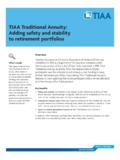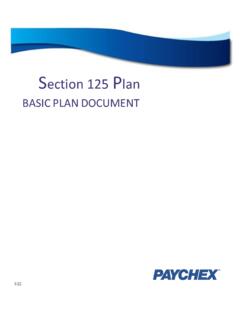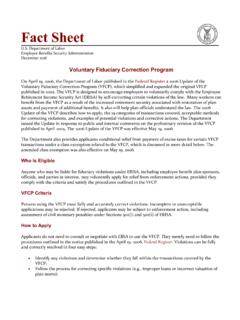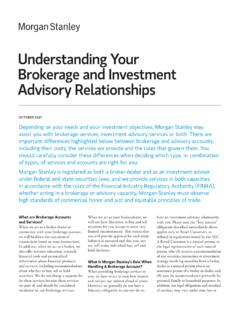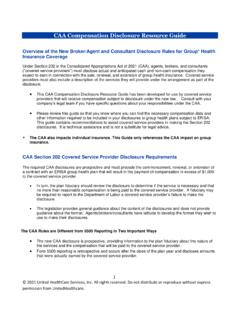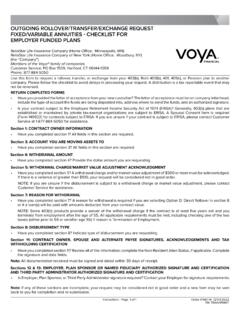Transcription of WHAT MAKES A 403(b) PLAN SUBJECT TO ERISA AND WHAT …
1 WHAT MAKES A 403(b) PLAN SUBJECT TO ERISA . AND WHAT ARE THE CONSEQUENCES? The employee retirement income security Act of 1974 ( ERISA ) is a federal law containing detailed rules that plan sponsors and other fiduciaries must comply with when setting up and operating retirement and other employee benefit plans. ERISA requires plan sponsors to file government reports, provide information to participants, protect plan assets and deliver benefits to participants. 403(b) PLANS SUBJECT TO ERISA 403(b) PLANS EXEMPT FROM ERISA .
2 Most 403(b) plans, like other employee benefit Some types of 403(b) plans are exempt from ERISA : plans, are SUBJECT to ERISA if they are sponsored by Governmental plans ( , plans sponsored by private tax-exempt employers. a state, county, or municipality or one of their You can generally assume that your 403(b) plan is agencies, schools, or instrumentalities). SUBJECT to ERISA unless it qualifies for one of the Church plans, unless the plan sponsor has voluntarily exemptions listed in the right column. elected to have the plan covered by ERISA .
3 If you are a private employer, you might make your Supplemental 403(b) elective deferral arrangements supplemental elective deferral only 403(b) plan (TDA plans) sponsored by private tax-exempt organi- ( TDA plan) SUBJECT to ERISA if you become too zations, if certain Department of Labor requirements involved in plan administration by taking such are satisfied: actions as: Plan participation is completely voluntary;. Determining which employees qualify for loans or The only form of plan contributions allowed is hardship distributions, or employee elective deferrals (pretax or Roth).
4 Denying fund sponsors reasonable access Participants are offered a reasonable choice of to participants. investment options (the DOL has informally indicated See third bullet point in the right column for more that there should be at least two different vendors'. information on the ERISA exemption for TDA plans products available);. sponsored by private tax-exempt organizations. Employees are provided with information on plan investment options;. Employer involvement in plan administration is limited to optional activities related to administering elective deferral agreements and does not involve discretionary determinations (such as hardship determinations).
5 The employer does not attempt to intervene in disputes between employees and fund sponsors or third-party administrators; and The employer does not receive compensation for Summary Annual Report (SAR). A summary of the performing administrative duties for the plan (other information included in the Form 5500 filing must than reimbursement of actual expenses). be provided to participants within nine months of the end of the plan year. Note: Just having a written plan document, as required by final 403(b) regulations, will not make an otherwise Summary Plan Description (SPD).
6 A summary of exempt TDA plan SUBJECT to ERISA . plan provisions must be provided to all participants Governmental and non-electing church plans are and beneficiaries when they first become eligible, exempt from ERISA whether they have employer contri- on request, and at least once every five years. butions, employee elective deferrals, or both. These Summary of Material Modification (SMM). A summary organizations are exempt because they are governmental of significant changes in plan provisions must be or church organizations, not because of the kind of provided to participants and beneficiaries within 210.
7 Contributions made to their plans. days of the end of a plan year in which the plan was amended, if a revised SPD has not been provided. BENEFITS? Joint and Survivor Annuity Options must be provided The benefits of ERISA coverage for 403(b) plans are: if annuity contracts are used as funding vehicles. State laws and regulations generally do not apply. Nondiscrimination rules apply to employer contribu- Employers can take control over the design, operation tions, if highly compensated employees are eligible and assets of the plan making compliance problems for the plan.
8 All TDA plans are SUBJECT to the universal less likely. availability requirement. The employer is protected from liability for invest- Minimum participation standards apply to the wait- ment losses arising from participant investment ing period for eligibility for employer contributions decisions, if the plan satisfies ERISA Section 404(c) (generally the earlier of age 21 or one year of service). standards for investment diversification, participant Vesting rules apply to employer contributions. transfer rights, and participant financial education.
9 Plan sponsors, administrators and other fiduciaries Employees' benefits and rights will be eligible for must comply with ERISA 's fiduciary standards. ERISA protection. Employers must comply with ERISA claims procedures, DRAWBACKS? when handling benefit requests from participants The main drawbacks of ERISA coverage for 403(b) plans and beneficiaries. are ERISA 's reporting and disclosure requirements: FURTHER INFORMATION. Form 5500 must be filed with the DOL each year: ERISA information, including a description of the For the 2008 plan year (due by July 31, 2009.)
10 Major requirements and links to further information for calendar year plans) 403(b) plans are not regarding plan documents, SPDs, and Form 5500. required to file the full Form 5500. filing requirements, can be found on TIAA-CREF's Starting with Form 5500 filings for 2009 plan Administrator Website at: years (due by July 31, 2010 for calendar year compliance/ Publications are plans), 403(b) plans will be SUBJECT to the same available at Form 5500 filing requirements as qualified plans, including financial schedules, vendor compensation information and copies of plan audit reports (for plans with more than 100 participants).

